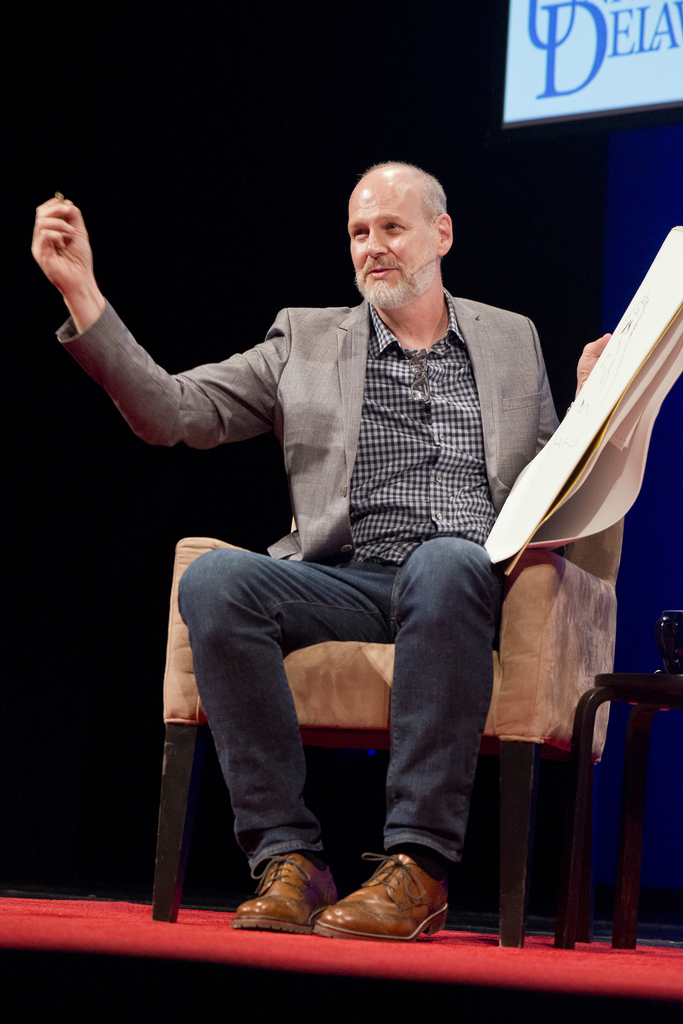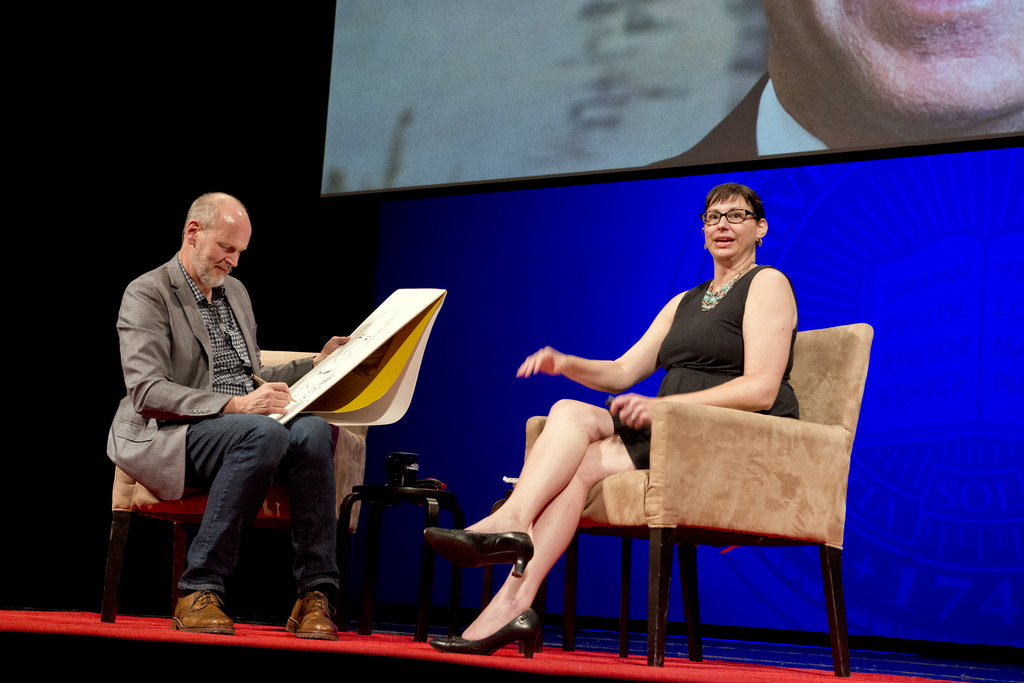National Agenda with Rob Rogers : An American Tradition
Cartoonist discusses the importance and influence of editorial cartoons
By Charlotte Groves, University of Delaware senior and intern for the University of Delaware’s Center for Political Communication
Watch the video. Read the transcript. Listen to and download the podcast. Read the news story in The Review. View Rob Rogers’s presentation.
SEPTEMBER 19, 2019?”Even the founding fathers were into political cartooning,” said Rob Rogers. The tradition goes all the way back to the mid-1700s when famous figures in history such as Benjamin Franklin and Paul Revere used cartoons to rally support for colonial independence. The University of Delaware welcomed Rogers to its second event in the National Agenda speaker series, “Direction Democracy,” which took place on September 11.

Rogers, an award-winning, nationally syndicated editorial cartoonist, was fired from the Pittsburgh Post-Gazette in 2018 for drawing cartoons that criticized President Trump. Rogers has been drawing political cartoons for more than 30 years.
During a presentation of his work, Rogers explained that sometimes ideas come to him visually after seeing something on the news. He displayed his cartoon of former Vice President Dick Cheney as the Statue of Liberty. Cheney had been in the news, defending interrogation techniques, and the CIA has just released a torture report. “And so, I imagined, what about our civil liberties, and that immediately made me think of the Statue of Liberty,” said Rogers. “I thought, okay, I’ll draw Cheney as the Statue of Liberty. So, here he is”and there he has the torture handbook and he’s saying, ‘Bring us your huddled masses yearning to be waterboarded.’”
Rogers shared the work of Thomas Nast to illustrate the history and influence of editorial cartoons in American politics. Known as the “Father of the American Cartoon,” Nast was most famous for exposing corruption in Tammany Hall, a New York City political organization, which was led by William “Boss” Tweed during the late 1800s. Tweed famously complained about the unwanted publicity, saying “I don’t care so much what the papers write; my constituents can’t read. It’s them damn pictures.” Tweed was ultimately arrested for corruption in 1871.
Every day, Rogers begins with a sketchbook and depending on the day he jots down topics. “I look at two topics that are very different and very disparate and I think, what if I combine those, that would be a surprise,” said Rogers. On February 3, 2004, for example, he combined the two topics: Groundhog’s Day and weapons of mass destruction intelligence. He drew a mortally wounded Punxsutawney Phil and President Bush with a smoking shotgun saying, “I was wrong about having weapons of mass destruction, but he was still a threat.”

If it is not evident yet, Rogers cartoons from the left. “Cartoonists are paid to have their own opinions most of the time. So, I was a progressive, liberal cartoonist,” said Rogers. “I did draw cartoons about conservative and liberal presidents but certainly my politics and Obama’s politics were more aligned, so they weren’t the vicious cartoons,” said Rogers. “I did try to address as many of the issues as I could, no matter whether it was Democrats or Republicans.”
The Pittsburgh Post-Gazette began to shift from liberal-progressive to a more conservative stance in 2015, when its conservative publisher, John Robinson Block, hinted about endorsing the candidacy of Donald Trump. “My editorial page editor who championed and defended me to management took a buyout in 2016 rather than endorse Donald Trump,” said Rogers.
One of the things I wanted to illustrate here is how it’s sort of unusual that a political cartoonist who is drawing cartoons about a president would be fired for doing his job.” Having cartoons killed happens, and Rogers typically had about one or two killed a year. The year he was fired though, his new editor killed 18 cartoons within three months. “After 25 years as the political cartoonist for the Pittsburgh Post-Gazette I was fired in June [2018] for being too critical of the president,” referring to President Trump. Rogers’s firing brought media attention including an article in the opinion section of the New York Times.
About National Agenda
The ninth annual National Agenda speaker series, hosted by the University of Delaware’s Center for Political Communication, brings nationally known speakers to campus and encourages students, staff, faculty, and community members to join the conversation. CPC Associate Director Lindsay Hoffman, an associate professor of communication at UD, directs the series. This year’s theme, “Direction Democracy”, explores where we have been, where we are going, and the current state of democracy in the United States. National Agenda is free and open to the public. It is made possible with support from the University of Delaware’s Office of the Provost and the College of Arts and Sciences. For more information, please visit cpc.udel.edu/nationalagenda.
